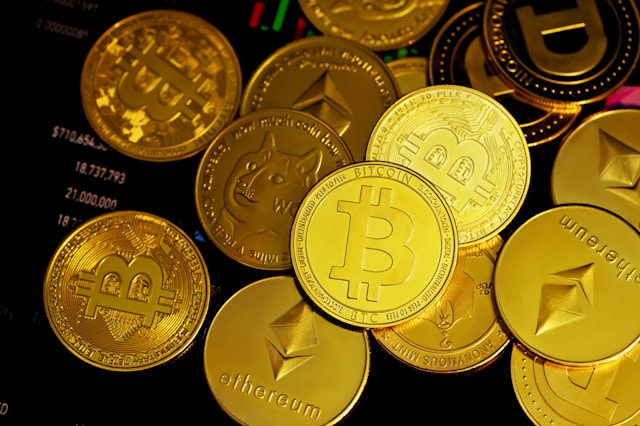Table of Contents
Stablecoins are a type of cryptocurrency designed to maintain a stable value by pegging their worth to another stable asset, such as fiat currency like the US dollar or a commodity like gold.
Unlike other cryptocurrencies like Bitcoin, which can experience significant price fluctuations, stablecoins aim to provide a more reliable store of value and a medium of exchange.
Another Bitcoin platform, bitcoin-code.app/ offers a solution to this issue by providing a stable medium of exchange and store of value, which can help mitigate the risks associated with volatile currencies.
The Importance of Economic Stability
Economic stability is crucial for sustainable economic growth and development. Volatility in currency values can lead to uncertainty and reduce confidence in financial systems. Stablecoins offer a solution to this issue by providing a stable medium of exchange and store of value, which can help mitigate the risks associated with volatile currencies.
Types of Stablecoins
There are several types of stablecoins, each with its method of maintaining price stability:
- Fiat-Collateralized Stablecoins: These stablecoins are backed by reserves of fiat currency held in a bank account. Examples include USDC (USD Coin) and Tether (USDT).
- Crypto-Collateralized Stablecoins: These stablecoins are backed by reserves of other cryptocurrencies. They use smart contracts to maintain stability. Examples include DAI and sUSD.
- Algorithmic Stablecoins: These stablecoins use algorithms to regulate the supply of the stablecoin based on demand. Examples include Terra (LUNA) and Ampleforth (AMPL).

Case Studies: Stablecoins in Action
Stablecoins have been used in various countries to address economic instability and provide a reliable means of exchange. For example, in Venezuela, where hyperinflation has rendered the local currency virtually worthless, stablecoins like USDT and DAI have been used as a more stable alternative for everyday transactions.
In Argentina, where the national currency has also experienced significant volatility, stablecoins have been used to protect against inflation and preserve wealth. These examples demonstrate the real-world utility of stablecoins in mitigating volatility risks.
Regulatory Challenges and Responses
The regulatory landscape for stablecoins is complex and varies from country to country. Some governments have expressed concerns about the potential impact of stablecoins on financial stability and monetary policy. As a result, regulatory responses have been mixed, with some countries imposing strict regulations on stablecoin issuers, while others have embraced them to improve financial inclusion and promote innovation.
Stablecoins and Financial Inclusion
One of the key benefits of stablecoins is their potential to improve financial inclusion by providing access to stable and reliable financial services. In developing countries where traditional banking infrastructure is lacking, stablecoins can offer a secure and cost-effective way to store and transfer value.
For example, in sub-Saharan Africa, where many people do not have access to traditional banking services, stablecoins like USDT and DAI are being used to facilitate cross-border payments and remittances. This not only helps to reduce the cost of sending money but also provides a more reliable means of transferring value across borders.

Future Outlook: Innovations and Challenges
The future of stablecoins looks promising, with many innovative projects in development. For example, some stablecoins are exploring the integration of central bank digital currencies (CBDCs) to enhance stability and regulatory compliance.
However, there are also challenges ahead, particularly around security and governance. Stablecoins are only as reliable as the assets backing them, so ensuring transparency and accountability will be crucial for their long-term success.
Conclusion
Stablecoins play a vital role in ensuring economic stability by providing a reliable medium of exchange and store of value. They offer a practical solution to the challenges of volatility in traditional currencies and have the potential to revolutionize the way we think about money and finance. As the technology matures and regulatory frameworks evolve, stablecoins are likely to become an increasingly important part of the global financial system.
Author Profile
- Blogger and Educator by Passion | Senior Online Media & PR Strategist at ClickDo Ltd. | Contributor to many Education, Business & Lifestyle Blogs in the United Kingdom & Germany | Summer Course Student at the London School of Journalism and Course Instructor at the SeekaHost University.
Latest entries
 BusinessDecember 2, 2025How to Build an Effective Progression Plan in Your Company
BusinessDecember 2, 2025How to Build an Effective Progression Plan in Your Company BusinessOctober 24, 2025Legionella Risk Assessment: 5 Things Every Entrepreneur Needs to Know
BusinessOctober 24, 2025Legionella Risk Assessment: 5 Things Every Entrepreneur Needs to Know EmploymentSeptember 2, 2025Why Motorbike Accident Staff Claims are a Growing Business Risk
EmploymentSeptember 2, 2025Why Motorbike Accident Staff Claims are a Growing Business Risk FinanceAugust 21, 2025A Swiss Bank Account for Foreigners: Stability, Tradition, and Options for International Clients
FinanceAugust 21, 2025A Swiss Bank Account for Foreigners: Stability, Tradition, and Options for International Clients





